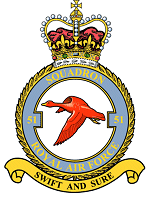| No. 51 Squadron RAF | |
|---|---|
 | |
| Active | 15 May 1916 – 1 April 1918 (RFC) 1 April 1918 – 13 June 1919 (RAF) 5 March 1937 – 30 October 1950 21 August 1958 – present |
| Country | United Kingdom |
| Branch | Royal Air Force |
| Type | Flying squadron |
| Role | Signals intelligence |
| Size | Three aircraft |
| Part of | No. 1 Group |
| Home station | RAF Waddington |
| Nickname(s) | 'York's own squadron' |
| Motto(s) | Swift and Sure[1] |
| Aircraft | Boeing RC-135W Airseeker |
| Battle honours | Home Defence (1916–1918)*, Channel and North Sea (1940–1943), Norway (1940)*, France and Low Countries (1940), Ruhr (1940–1945)*, Fortress Europe (1940–1944), German Ports (1940–1945), Invasion Ports (1940), Biscay Ports (1940–1944), Berlin 1940–1944, Baltic 1940–1944*, Biscay 1942, Italy (1943)*, France and Germany (1944–1945)*, Normandy (1944), Walcheren, Rhine, South Atlantic 1982, Gulf (1991), Kosovo, Iraq (2003–2011), Libya (2011) * Honours marked with an asterisk may be emblazoned on the Squadron Standard |
| Insignia | |
| Squadron badge heraldry | A goose volant, chosen as a play on the word 'Anson', the aircraft which the squadron was flying when the badge was being designed, as 'Anser' is the Latin word for Goose, and it was felt that a heavy wild fowl was appropriate for a bomber squadron. Approved by King George VI in December 1937. |
| Squadron codes | UT (Aug 1939 – Sep 1939) MH (Sep 1939 – May 1945) LK (? – Jan 1944) ('C' Flt which became 578 Sqn) C6 (Jan 1944 – May 1945) ('C' Flt) TB (May 1945 – Dec 1949) MH (Dec 1949 – Oct 1950) |
Number 51 Squadron is a squadron of the Royal Air Force. Since 2014 it has operated the Boeing RC-135W Airseeker R.1, more commonly referred to as the Rivet Joint, from RAF Waddington, Lincolnshire.
It had previously flown the Hawker Siddeley Nimrod R.1 from 1974 until 2011.[2] Following the Nimrod's retirement, crews from No. 51 Squadron trained alongside the United States Air Force on the RC-135W Rivet Joint, which was being acquired by the RAF under the Airseeker project.[3][4][5]
- ^ Pine, L.G. (1983). A dictionary of mottoes (1 ed.). London: Routledge & Kegan Paul. p. 227. ISBN 0-7100-9339-X.
- ^ "Nimrod R1 makes final flight" Archived 25 March 2012 at the Wayback Machine Defence Management Journal, 28 June 2011. Retrieved: 28 June 2011.
- ^ "Ministry of Defence – The Major Projects Report 2012 Appendix 3" (PDF). National Audit Office. 8 January 2013. p. 32. Archived from the original (PDF) on 19 December 2013.
- ^ "New RAF Intelligence Aircraft Arrives in UK Seven Months Early". www.defense-aerospace.com.
- ^ Perry, Dominic (12 November 2013). "PICTURES: First RAF Rivet Joint aircraft arrives in UK". Flight Global. Retrieved 18 December 2013.